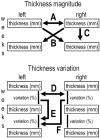Relationships in Ongoing Structural Maintenances of the Two Cerebral Cortices of an Individual Brain
- PMID: 30202210
- PMCID: PMC6122241
- DOI: 10.1177/1179069518795875
Relationships in Ongoing Structural Maintenances of the Two Cerebral Cortices of an Individual Brain
Abstract
A human brain has separate left and right cerebral cortices, each of which must be continuously structurally maintained during adulthood. There is no understanding of how ongoing structural maintenances of separate parts of a mature individual brain, including the 2 cortices, are related. To explore this issue, this study used an unconventional N-of-1 magnetic resonance imaging time-series paradigm to identify relationships between maintenances of structural thicknesses of the 2 cortices in an adult human brain over week intervals for 6 months. The results suggest that maintenances of left and right cortical thicknesses were symmetrically related in some, but asymmetrically related in other, respects. For matched times, thickness magnitudes and variations on the 2 sides were positively correlated and appeared to reflect maintenance symmetry. Maintenance relationships also extended from earlier to later times with temporal continuity and apparent "if-then" contingencies which were reflected in symmetry and asymmetry dynamics spanning 1- to 2-week periods. The findings suggest concepts of individual brain cortical maintenance symmetry, asymmetry, and temporal continuity dynamics that have not been previously recognized. They have implications for defining cortical maintenance traits or states and for development of N-of-1 precision medicine paradigms that can contribute to understanding individual brain health.
Keywords: Brain maintenance; MRI N-of-1 time series; cortical symmetry/asymmetry; cortical thickness; precision medicine.
Conflict of interest statement
Declaration of conflicting interests:The author(s) declared no potential conflicts of interest with respect to the research, authorship, and/or publication of this article.
Figures




Similar articles
-
Temporal Interactions between Maintenance of Cerebral Cortex Thickness and Physical Activity from an Individual Person Micro-Longitudinal Perspective and Implications for Precision Medicine.J Pers Med. 2024 Jan 23;14(2):127. doi: 10.3390/jpm14020127. J Pers Med. 2024. PMID: 38392561 Free PMC article.
-
Interaction of Sleep and Cortical Structural Maintenance From an Individual Person Microlongitudinal Perspective and Implications for Precision Medicine Research.Front Neurosci. 2020 Jul 31;14:769. doi: 10.3389/fnins.2020.00769. eCollection 2020. Front Neurosci. 2020. PMID: 32848551 Free PMC article.
-
An Exploration Into Short-Interval Maintenance of Adult Hemispheric Cortical Thickness at an Individual Brain Level.J Exp Neurosci. 2017 Sep 26;11:1179069517733453. doi: 10.1177/1179069517733453. eCollection 2017. J Exp Neurosci. 2017. PMID: 28989284 Free PMC article.
-
Hemispheric asymmetries of cortical volume in the human brain.Cortex. 2013 Jan;49(1):200-10. doi: 10.1016/j.cortex.2011.11.002. Epub 2011 Nov 19. Cortex. 2013. PMID: 22176871
-
Structure, functional and cerebral asymmetry: in vivo morphometry of the planum temporale.Neurosci Biobehav Rev. 1996 Winter;20(4):587-91. doi: 10.1016/0149-7634(95)00071-2. Neurosci Biobehav Rev. 1996. PMID: 8994197 Review.
Cited by
-
Temporal Interactions between Maintenance of Cerebral Cortex Thickness and Physical Activity from an Individual Person Micro-Longitudinal Perspective and Implications for Precision Medicine.J Pers Med. 2024 Jan 23;14(2):127. doi: 10.3390/jpm14020127. J Pers Med. 2024. PMID: 38392561 Free PMC article.
-
Interaction of Sleep and Cortical Structural Maintenance From an Individual Person Microlongitudinal Perspective and Implications for Precision Medicine Research.Front Neurosci. 2020 Jul 31;14:769. doi: 10.3389/fnins.2020.00769. eCollection 2020. Front Neurosci. 2020. PMID: 32848551 Free PMC article.
References
-
- Vrselja Z, Brkic H, Curic G. Arterial tree asymmetry reduces cerebral pulsatility. Med Hypotheses. 2015;85:622–627. - PubMed
LinkOut - more resources
Full Text Sources
Other Literature Sources

